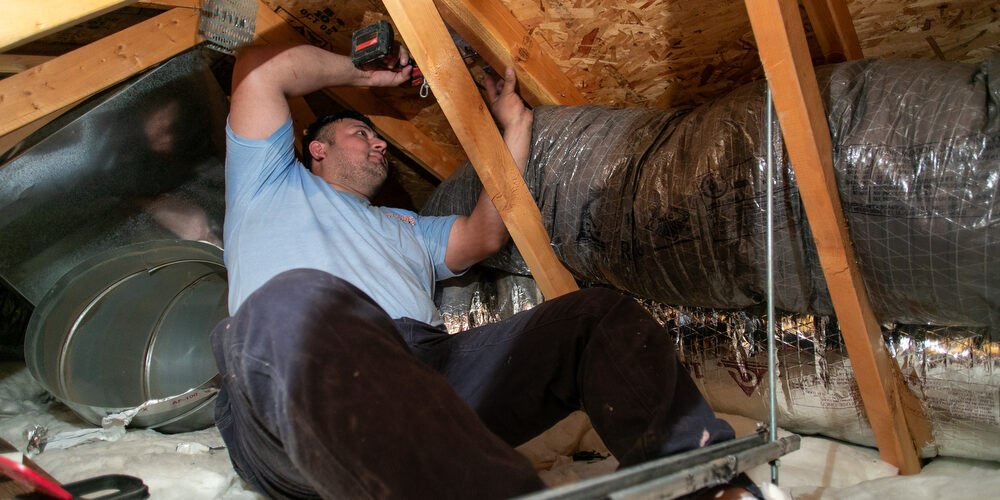Imagine coming back home after a tiring day to the warm, nature-friendly fragrance of fresh air. That feeling of relaxation and well-being comes courtesy of two powerful systems: heating and ventilation.
This comprehensive guide to heating and ventilation will cover its fundamentals, their workings, and why their collaboration is critical for overall comfort. By the time this article ends, you should have enough knowledge to make educated decisions and breathe easy!
What Is Heating?
Heating refers to the process of increasing temperature within an object or area. Heating systems are intended to make indoor spaces comfortable during the winter season by raising temperatures. They also prevent pipes from freezing over and moisture accumulation that might otherwise lead to mold growth.
How Heating Systems Work
Heating systems come in all forms, but all follow a similar concept: the process of acquiring thermal energy from your surroundings to produce a rise in the temperature in your space. Here is an overview of various heater models that fulfill this role:
- Forced-air heating systems: The leading type of forced-air system is the boiler or furnace, which uses heat energy to warm the air that is then distributed throughout a home’s ventilation system by fan circulation through the vent and ducts. Energy sources for these artificial air systems are usually natural gas, propane, oil, and electricity.
- Radiant heating systems: Radiant heating devices directly heat objects or people within a room without warming the air directly. Examples include radiant floor heating that uses electricity from pipelines or hot pipes and radiant wall panels that emit heat directly.
- Hydronic heating systems: Hydronic systems utilize hot water as the source of warmth in homes. They heat water in a boiler before sending it through pipes, radiators, and baseboards before emitting heat into the atmosphere as it radiates off the surfaces.
- Geothermal heating systems: Geothermal systems utilize steady temperatures below the Earth’s surface to efficiently heat homes. A network of pipes buried deep below the Earth absorbs heat and transports it to the heat pump in your house, which disperses this warmth around your living areas.
What Is Ventilation?
Ventilation refers to the process of moving air around spaces. Within buildings, ventilation systems extract stale, dirty, and odorous air before exchanging it for fresh outdoor air. This helps restore oxygen while simultaneously decreasing pollution and managing moisture.
How Ventilation Systems Work
There are two primary forms of ventilation systems. They include:
- Natural ventilation relies on natural forces like wind and temperature fluctuations to circulate air through doors, windows, and vents. It is an energy-saving and cheap technique, yet it is dependent upon weather patterns for adequate functioning and may not always deliver the desired conditions.
- Mechanical ventilation: Mechanical systems for ventilation use fans and ducts to circulate airflow inside buildings to regulate temperatures. Here are a few typical examples where such mechanical systems have been utilized:
- Exhaust ventilation: Exhaust fans are installed in some rooms, such as bathrooms, kitchens, and laundry rooms, to remove polluted air that collects there.
- Supply ventilation: Supply fans draw fresh air in from outside and filter it if necessary before spreading it around your area.
- Balanced ventilation: With this system in place, supply and exhaust ventilation fans are carefully balanced. They deliver an equal amount of fresh air from the supply fans to the exhaust air taken out by the exhaust fans.
- Energy recovery ventilation (ERV) systems: ERV systems utilize the warmth or coolness of outgoing exhaust air and transfer it directly into incoming fresh air, thus making your home more energy-efficient.
The Importance Of Heating And Ventilation
Heating and ventilation, though seemingly distinct services, work hand in hand to create a pleasant living space that is energy-efficient and healthy for its occupants. Here’s why this duo makes an effective team:
- Comfort control: Although reliable heating systems will keep you warm, without proper ventilation, the warm air could become stagnant and stuffy. Ventilation ensures constant circulation of fresh air to create pleasant warmth without stagnation and stuffiness.
- Healthy indoor air quality: Homes built today that use modern insulation techniques can keep dust, allergens, and harmful gases at bay. Installing ventilation systems filters them out to improve indoor air quality while alleviating respiratory discomfort.
- Moisture management: Heating can create dry air, while inadequate ventilation could produce excess humidity. A balanced approach will help control humidity levels to protect dry, flaky skin and respiratory issues in the winter and reduce mold growth during the summer.
- Energy efficiency: Proper ventilation continuously provides fresh air, which reduces the burden on your heating system to constantly reheat the same stagnant air, leading to potential cost savings and energy efficiency gains.
- Peace of mind: An efficient heating and ventilation system provides peace of mind by creating safe and healthy living environments by controlling temperatures and air quality effectively.
Conclusion
Always remember that maintaining an efficient heating and ventilation system ensures comfort and can also help protect health while saving on energy bills.
If you’re preparing to put in your systems and are seeking competent advice regarding heating and ventilation St Grorge, Kuhn’s Heating & Air stands out as the preferred option. Our skilled technicians can assess your requirements before offering advice about which system will provide optimal comfort levels and warrant the best installation and upkeep. Contact us now to breathe easy and live comfortably.







